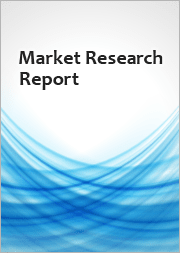
|
시장보고서
상품코드
1678088
세계의 아몬드 버터 시장 규모, 점유율, 성장 분석 : 성질별, 유형별, 유통 채널별, 지역별 - 산업 예측(2025-2032년)Almond Butter Market Size, Share, and Growth Analysis, By Nature (Organic, Conventional), By Type (Regular, Flavored), By Distribution Channel, By Region - Industry Forecast 2025-2032 |
||||||
아몬드 버터 세계 시장 규모는 2023년 34억 1,000만 달러로 평가되었습니다. 또한, 2024년 36억 8,000만 달러에서 2032년에는 67억 달러로 성장하고, 예측 기간(2025-2032년) 동안 7.8%의 연평균 복합 성장률(CAGR)을 보일 것으로 예측됩니다.
건강 식품에 대한 전 세계 소비자 수요는 기호 변화와 영양에 대한 인식의 변화로 인해 크게 증가하고 있으며, 이는 향후 몇 년동안 아몬드 버터의 판매를 촉진할 것으로 예상됩니다. 이 크리미한 아몬드 스프레드는 기존의 탄수화물과 지방이 많은 스프레드를 대체할 수 있는 건강한 아침 식사 스프레드로, 채식주의와 식물성 식단을 선호하는 추세에 부응하는 건강한 대안입니다. 고단백질과 건강한 지방을 함유한 아몬드 버터는 건강을 중시하는 사람들과 영양가 높은 대안을 찾는 사람들에게 어필할 수 있습니다. 또한, 아몬드 섭취와 관련된 심혈관계에 대한 혜택은 아몬드 버터 시장 매력을 더욱 높여주고 있습니다. 제품 혁신이 제조업체의 초점이 되면서 아몬드 버터에 대한 수요는 장기적으로 선진국에서 신흥국에 비해 특히 견고하게 유지될 것으로 예상됩니다.
목차
서론
- 조사 목적
- 조사 범위
- 정의
조사 방법
- 정보 조달
- 2차와 1차 데이터 방법
- 시장 규모 예측
- 시장 전제조건과 제한
주요 요약
- 세계 시장 전망
- 공급과 수요 동향 분석
- 부문별 기회 분석
시장 역학과 전망
- 시장 개요
- 시장 규모
- 시장 역학
- 성장 촉진요인과 기회
- 성장 억제요인과 과제
- Porter의 Five Forces 분석
주요 시장 인사이트
- 중요 성공 요인
- 경쟁 정도
- 주요 투자 기회
- 시장 생태계
- 시장의 매력 지수(2024년)
- PESTEL 분석
- 거시경제 지표
- 밸류체인 분석
- 가격 분석
- 사례 연구
- 고객과 구매 기준 분석
- 원재료 분석
아몬드 버터 시장 규모 : 성질별&CAGR(2025-2032년)
- 시장 개요
- 오가닉
- 기존
아몬드 버터 시장 규모 : 유형별&CAGR(2025-2032년)
- 시장 개요
- 기존
- 풍미
아몬드 버터 시장 규모 : 유통 채널별&CAGR(2025-2032년)
- 시장 개요
- 슈퍼마켓 및 하이퍼마켓
- 전문점
- 온라인 스토어
- 기타
아몬드 버터 시장 규모 : 지역별&CAGR(2025-2032년)
- 북미
- 미국
- 캐나다
- 유럽
- 독일
- 스페인
- 프랑스
- 영국
- 이탈리아
- 기타 유럽
- 아시아태평양
- 중국
- 인도
- 일본
- 한국
- 기타 아시아태평양
- 라틴아메리카
- 브라질
- 기타 라틴아메리카
- 중동 및 아프리카
- GCC 국가
- 남아프리카공화국
- 기타 중동 및 아프리카
경쟁 정보
- 주요 5개사 비교
- 주요 기업의 시장 포지셔닝(2024년)
- 주요 시장 기업이 채택한 전략
- 최근 시장 동향
- 기업의 시장 점유율 분석(2024년)
- 주요 기업 개요
- 기업 상세
- 제품 포트폴리오 분석
- 기업 부문별 점유율 분석
- 매출 전년대비 비교(2022-2024년)
주요 기업 개요
- The J.M. Smucker Company(USA)
- Hormel Foods Corporation(USA)
- Barney Butter(USA)
- Nutty Novelties(USA)
- 8th Avenue Food & Provisions(USA)
- Hallstar Company(USA)
- The Hain Celestial Group, Inc.(USA)
- Cache Creek Foods(USA)
- Nuts'N More(USA)
- Once Again Nut Butter Collective, Inc.(USA)
- SOPHIM IBERIA S.L.(Spain)
- Treehouse Almonds(USA)
- Blue Diamond Growers(USA)
- Morrisons Ltd.(UK)
- Rolling Hills Nut Company(USA)
- MaraNatha(USA)
- Artisana Organics(USA)
- Premier Organics(USA)
- CalPure Foods, Inc.(USA)
결론과 제안
LSH 25.04.21Global Almond Butter Market size was valued at USD 3.41 billion in 2023 and is poised to grow from USD 3.68 billion in 2024 to USD 6.7 billion by 2032, growing at a CAGR of 7.8% during the forecast period (2025-2032).
Global consumer demand for healthy food products is witnessing a significant surge, driven by changing preferences and heightened awareness of nutrition, which is set to propel almond butter sales in the coming years. This creamy almond spread offers a healthier breakfast alternative to traditional carb and fat-heavy spreads, catering to the rising trend toward veganism and plant-based diets. With its high protein and healthy fat content, almond butter appeals to health-conscious individuals and those seeking nutritious alternatives. Moreover, the cardiovascular benefits linked to almond consumption further enhance its market appeal. As product innovation becomes a focal point for manufacturers, demand for almond butter is expected to be particularly robust in developed economies compared to developing regions in the long term.
Top-down and bottom-up approaches were used to estimate and validate the size of the Global Almond Butter market and to estimate the size of various other dependent submarkets. The research methodology used to estimate the market size includes the following details: The key players in the market were identified through secondary research, and their market shares in the respective regions were determined through primary and secondary research. This entire procedure includes the study of the annual and financial reports of the top market players and extensive interviews for key insights from industry leaders such as CEOs, VPs, directors, and marketing executives. All percentage shares split, and breakdowns were determined using secondary sources and verified through Primary sources. All possible parameters that affect the markets covered in this research study have been accounted for, viewed in extensive detail, verified through primary research, and analyzed to get the final quantitative and qualitative data.
Global Almond Butter Market Segments Analysis
Global Almond Butter Market is segmented by Nature, Type, Distribution Channel and region. Based on Nature, the market is segmented into Organic and Conventional. Based on Type, the market is segmented into Regular and Flavored. Based on Distribution Channel, the market is segmented into Supermarkets/Hypermarkets, Specialty Stores, Online Stores and Others. Based on region, the market is segmented into North America, Europe, Asia Pacific, Latin America and Middle East & Africa.
Driver of the Global Almond Butter Market
The Global Almond Butter market is primarily driven by its superior health benefits compared to conventional peanut butter, being richer in healthy fats and essential nutrients. As consumers worldwide increasingly lean towards foods that offer higher nutritional value, the demand for almond butter is projected to rise significantly. This shift in consumer preference towards healthier options is expected to further enhance the market's growth prospects. As awareness about the advantages of almond butter continues to spread, it is likely to become a prominent choice for health-conscious individuals, thus reinforcing its position in the global food market.
Restraints in the Global Almond Butter Market
The global almond butter market faces significant restraints due to factors such as unpredictable weather patterns, variability in crop yields, and disruptions within the supply chain. These elements contribute to price volatility in almond production, which directly influences the costs associated with producing and selling almond butter, as almonds are its primary ingredient. Fluctuations in almond prices can lead to reduced profit margins and hamper sales, ultimately hindering overall market growth. As a result, the uncertainty stemming from these issues poses a challenge for producers and can deter potential investors in the almond butter sector.
Market Trends of the Global Almond Butter Market
The Global Almond Butter market is poised for significant growth driven by an escalating health and wellness consciousness among consumers. As people increasingly prioritize nutritious diets, the demand for healthier alternatives to traditional peanut butter is rising, with almond butter emerging as a favored choice due to its protein-rich content and health benefits. This trend is further bolstered by heightened awareness of the nutritional advantages associated with almond consumption, such as heart health and better metabolic function. Consequently, manufacturers are exploring innovative product formulations and marketing strategies to cater to this evolving consumer preference, positioning almond butter as a staple in health-oriented diets.
Table of Contents
Introduction
- Objectives of the Study
- Scope of the Report
- Definitions
Research Methodology
- Information Procurement
- Secondary & Primary Data Methods
- Market Size Estimation
- Market Assumptions & Limitations
Executive Summary
- Global Market Outlook
- Supply & Demand Trend Analysis
- Segmental Opportunity Analysis
Market Dynamics & Outlook
- Market Overview
- Market Size
- Market Dynamics
- Drivers & Opportunities
- Restraints & Challenges
- Porters Analysis
- Competitive rivalry
- Threat of substitute
- Bargaining power of buyers
- Threat of new entrants
- Bargaining power of suppliers
Key Market Insights
- Key Success Factors
- Degree of Competition
- Top Investment Pockets
- Market Ecosystem
- Market Attractiveness Index, 2024
- PESTEL Analysis
- Macro-Economic Indicators
- Value Chain Analysis
- Pricing Analysis
- Case Studies
- Customer & Buying Criteria Analysis
- Raw Material Analysis
Global Almond Butter Market Size by Nature & CAGR (2025-2032)
- Market Overview
- Organic
- Conventional
Global Almond Butter Market Size by Type & CAGR (2025-2032)
- Market Overview
- Regular
- Flavored
Global Almond Butter Market Size by Distribution Channel & CAGR (2025-2032)
- Market Overview
- Supermarkets/Hypermarkets
- Specialty Stores
- Online Stores
- Others
Global Almond Butter Market Size & CAGR (2025-2032)
- North America (Nature, Type, Distribution Channel)
- US
- Canada
- Europe (Nature, Type, Distribution Channel)
- Germany
- Spain
- France
- UK
- Italy
- Rest of Europe
- Asia Pacific (Nature, Type, Distribution Channel)
- China
- India
- Japan
- South Korea
- Rest of Asia-Pacific
- Latin America (Nature, Type, Distribution Channel)
- Brazil
- Rest of Latin America
- Middle East & Africa (Nature, Type, Distribution Channel)
- GCC Countries
- South Africa
- Rest of Middle East & Africa
Competitive Intelligence
- Top 5 Player Comparison
- Market Positioning of Key Players, 2024
- Strategies Adopted by Key Market Players
- Recent Developments in the Market
- Company Market Share Analysis, 2024
- Company Profiles of All Key Players
- Company Details
- Product Portfolio Analysis
- Company's Segmental Share Analysis
- Revenue Y-O-Y Comparison (2022-2024)
Key Company Profiles
- The J.M. Smucker Company (USA)
- Company Overview
- Business Segment Overview
- Financial Updates
- Key Developments
- Hormel Foods Corporation (USA)
- Company Overview
- Business Segment Overview
- Financial Updates
- Key Developments
- Barney Butter (USA)
- Company Overview
- Business Segment Overview
- Financial Updates
- Key Developments
- Nutty Novelties (USA)
- Company Overview
- Business Segment Overview
- Financial Updates
- Key Developments
- 8th Avenue Food & Provisions (USA)
- Company Overview
- Business Segment Overview
- Financial Updates
- Key Developments
- Hallstar Company (USA)
- Company Overview
- Business Segment Overview
- Financial Updates
- Key Developments
- The Hain Celestial Group, Inc. (USA)
- Company Overview
- Business Segment Overview
- Financial Updates
- Key Developments
- Cache Creek Foods (USA)
- Company Overview
- Business Segment Overview
- Financial Updates
- Key Developments
- Nuts 'N More (USA)
- Company Overview
- Business Segment Overview
- Financial Updates
- Key Developments
- Once Again Nut Butter Collective, Inc. (USA)
- Company Overview
- Business Segment Overview
- Financial Updates
- Key Developments
- SOPHIM IBERIA S.L. (Spain)
- Company Overview
- Business Segment Overview
- Financial Updates
- Key Developments
- Treehouse Almonds (USA)
- Company Overview
- Business Segment Overview
- Financial Updates
- Key Developments
- Blue Diamond Growers (USA)
- Company Overview
- Business Segment Overview
- Financial Updates
- Key Developments
- Morrisons Ltd. (UK)
- Company Overview
- Business Segment Overview
- Financial Updates
- Key Developments
- Rolling Hills Nut Company (USA)
- Company Overview
- Business Segment Overview
- Financial Updates
- Key Developments
- MaraNatha (USA)
- Company Overview
- Business Segment Overview
- Financial Updates
- Key Developments
- Artisana Organics (USA)
- Company Overview
- Business Segment Overview
- Financial Updates
- Key Developments
- Premier Organics (USA)
- Company Overview
- Business Segment Overview
- Financial Updates
- Key Developments
- CalPure Foods, Inc. (USA)
- Company Overview
- Business Segment Overview
- Financial Updates
- Key Developments



















